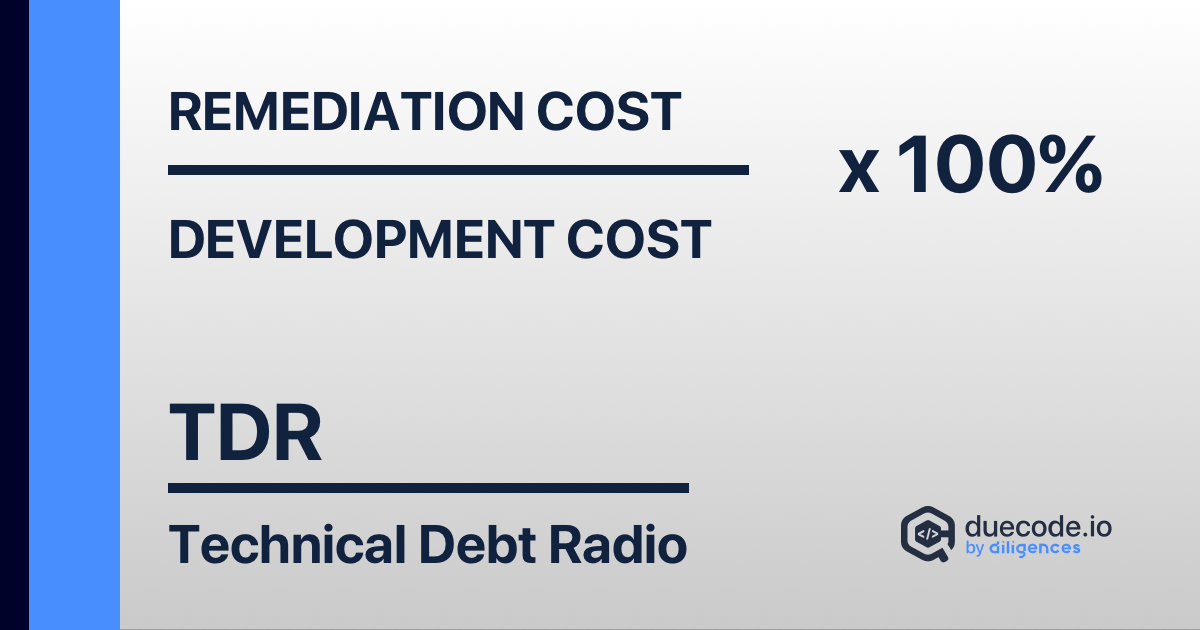How To Get Rid Of Technical Debt?
18 August 2021 8 min read

Audio Version Of This Article
Code quality often refers to two concepts in software engineering: quality in the program's core and quality in the inputs that support the program.
In certain terms, "code elegance" is a subtype of "quality." Or the definition of quality is the program's ability to be easily used and written without requiring a great deal of programming knowledge. Therefore programmers strive for "code elegance."
When a program is written, it may use any number of computer programs to compile it. Often, the programmer specifies the highest level of code quality so that low-level code (sometimes called "low-level code" or "low-level technology") may use more modern technology and perform better than the high-level code. Nevertheless, the possibility of developing technical debt in the process is always there.
What is Technical Debt?
Some refer to technical debt as the "hidden cost" of software development.
How Does Technical Debt Develop?
Think about a group of professional developers with restricted resources. A bypass (such as point-to-point integration) is used to deliver the work. When it comes to completing the project on schedule and fulfilling the business's requirements, they succeed fast. Isn't that great? On the opposite, it is accumulating technical debt that will take Time to pay off in the future.
To get rid of technical debt, it is important to understand why TD occurs. Reasons for technical debt include:
- The absence of available resources
- There is little time left
- Long-term damage isn't highlighted
Why is Technical Debt Bad?
Technical Debt is when a business has built a system that does not put code quality first. Instead, they have added new or enhanced features to that system and released them into the marketplace as they continue developing more strategies.
Over Time, this means that their code quality has started to fall behind the required standards.
There are many ways to reduce technical debt. Perhaps the best way is through hiring a team of quality assurance professionals who can ensure your software meets or exceeds the highest standards. If this is not feasible, consider outsourcing. There are companies out there that can guarantee your software meets or exceeds standards and will carry it on their books until such time as you can guarantee they have completed their work. Then you can eliminate some of the burden of technical debt.
How to Measure Technical Debt?
1.Technical Debt Ratio (TDR):
The expense of eliminating technical debt from the software in comparison to the development expense incurred to improve quality is called the technical debt ratio. It is estimated by taking finding out the percentage proportion of remediation cost out of development cost.TDR provides with a clear overview of all the factors contributing to TD.

2.Techniques for Analyzing Static Code
Such codes work on the codebase to find out problem areas such as inheritance and dependency. Other areas might be missing instructions, syntax inaccuracies, logical defects etc.
3.Costs of operations and business
The impact of technical debt on the operations of business is also an important aspect to measure. This involves both efficiency and affectivity of your operations. How many of your projects are delivered on time, what were the customer satisfaction levels etc.
How Can Companies Decrease Technical Debt?
To deal with technological debt, organizations may need to change their technology processes and change their mindset toward the business. Before proceeding, however, businesses must first determine whether this is something they would want to do.
Is the team using techniques that will be advantageous for the near term, such a one-to-one integration?
What proportion of project-by-project teams solely think about working on each project, without considering the possibility of using previous work to complete future tasks?
If the answer to these questions is "no," this opportunity is perfect for reducing technical debt.
How to Get Rid of Technical Debt?
You will minimize technical debt in numerous ways. It is also possible to make your software up to the highest standards by employing a team of quality assurance experts that can guarantee your applications meet or surpass these requirements. If this is not a possibility, you should consider outsourcing the project.
I know of certain firms that will provide you software with the assurance that it meets or exceeds established criteria and will keep it on their books until you can demonstrate that they have finished their job. Once you've gotten rid of some of the technical debt, you'll be able to reduce some of the responsibilities.
1.Putting Code Quality at the Top of the Priority List:
Other problems may be at play. The problems these difficulties may be associated with include code quality concerns since you created the code in the first place without thinking about the impact it will have on others. Alternatively, if the code does not work properly, what will happen if your company relies on this system?
Do you expect the public to have a degree of proficiency in your system which matches your competence, or do you expect them to operate with subpar equipment?
You should explore the lowering of technical debt if your response is the latter.
2.Looking through the code (Code Review):
Code review is essential to the health of a codebase. But, it is essential that any low-quality code be dealt with before it creates even more issues. Nevertheless, having excellent codebase is critical for every company.
Quality is essential for every organization. To ensure that the work is done on time, monitor Code Reviews throughout the development cycle. Understanding why features were not utilized as well as what was the reason that a release isn't as successful is beneficial.
a. A third-party review board
These consist of engineers with expertise in the existing project to review. These are experts in spotting problems, and they are able to suggest fixes that would remove or decrease potential hazards. They may also guarantee that your company will not be negatively affected by your software system.
b. Disadvantages of having a third-party review board:
While third-party review boards may be advantageous but are not budget-friendly instead, you may want to consider working with an independent technical consultant experienced with software engineering and development. It pays to work with the finest when working with software engineering and quality assurance in general. Using this new tool will help you prevent coding errors and therefore provide better code quality than you've ever seen before.
c. In-House Teams to Assess Quality:
However, no matter how qualified your software technicians are, there is no substitute for the judgment of another experienced person.
You should invest in an in-house team to assess code quality at regular intervals. By so doing, you can make the most informed decision regarding the software that you choose to run your business on. That decision will affect every aspect of your business. If your code quality needs to be improved, you will know it. If your vendors are reporting poor code quality, you will know it too.
d. Automated Code Reviews:
There is likely a greater emphasis on automation than there would be was the testing procedures for the programs involved to be based solely on manual labor. For one thing, there is likely less time available for employees to perform the testing themselves. Also, the tools available for Code Reviews make it possible for the reviewer to catch errors in the coding standards themselves instead of the more prominent issues on the software itself.
Lastly, because of the reduced amount of manual labor necessary to get the job done, the results from using automated code review tools will likely show a tremendous amount of productivity. By speeding up the process, the business owner can also get more value out of each employee, which leads to an increase in profitability.
3.Commitment to Quality:
All quality standards rely on a commitment to quality. Organizations can measure commitment to quality in several ways. One standard method is to see quality as the result of overall success. Successful companies are consistently ranked among the most cost-effective companies in the market. Therefore, the focus of any evaluation should be on how successful a company is at meeting its stated objectives and missions, not on how efficient it is at producing quality code.
What does this mean to your business?
First, it means that you have a software program working correctly for you and your company.
Secondly, it means that you are unlikely to encounter technical debt issues because your quality assurance team has completed their job.
4.Systematic Approach:
Companies also must assess their technical debt in a specific order. First, they must identify and document all sources of code quality concerns. Next, they must investigate each source and determine whether it merits attention. At this point, companies would be well advised to consider hiring a professional-quality Assessor. A technical debt expert will help the company identify the sources of technical debt, review documents relevant to each area of concern, develop a plan to resolve technical debt, and make technical corrections that improve code quality.
5.A Culture of Continuous Improvement:
Another way for companies to improve their quality code is through a process of continuous improvement. It consists of an analysis and determination of how well the current approaches are accomplishing the desired results and whether the organization could take any additional steps to achieve desired results. Continuous improvement involves analyzing, evaluating, designing, testing, documenting, and improving. It is an ongoing process that enhances the quality of all processes, products, and services.
6.Improve the Maintainability:
There are several ways that an IT manager can better grasp how well he maintains a product. One way to do this is by determining what kinds of measurements he uses to track of the TD. These measurements may include customer satisfaction and customer loyalty surveys, which are suitable measuring quality methods. If an IT manager is interested in keeping these measurements up to date, the Code Review team will likely benefit as well.
7.Proper Documentation:
There are many avenues available for addressing technical debt and quality control. A high-quality technical documentation process should include good-quality practice and a method of regular revision to keep the code current. A concise, unambiguous, and accurate description of the function and usage should appear throughout the documentation, including usage notes, design documentation, testing documentation, and user's manual. Additionally, quality assurance documentation should describe the testing procedures used and explain any findings that are not consistent with the Code Quality Guidelines.

The Inevitable Part of Technical Debt:
In general, software developers must commit to a certain level of technical debt to remain competitive. The story of technical debt varies, but it is usually nowhere near the magnitude of non-technical debt. Software developers incur technical debt when they buy new tools or code that they cannot fully understand. They incur technical debt when they write new code to resolve a current issue or implement new methods for expanding their product. When they fail to follow a plan to achieve a specific goal, they run into technical debt.
Bottom Line:
Companies must be able to measure quality assurance techniques and code review strategies. Management must determine which areas of the organization need improvement and how to prioritize them. It should perform manual code reviews at regular intervals. The effectiveness of the codebase and its maintenance is an essential factor when determining the level of commitment to maintaining the quality of the code.
The Code Quality Process and Documentation Processes will decrease cost, add usable time, and increase profitability. The cost savings may be in the form of reduced costs and delayed claims. Also, more accurate, clearer, and complete documentation may result in fewer technical debt issues. More precise documentation will also facilitate the acceptance of future software and hardware applications by customers and suppliers.
Updated on September 2, 2021





